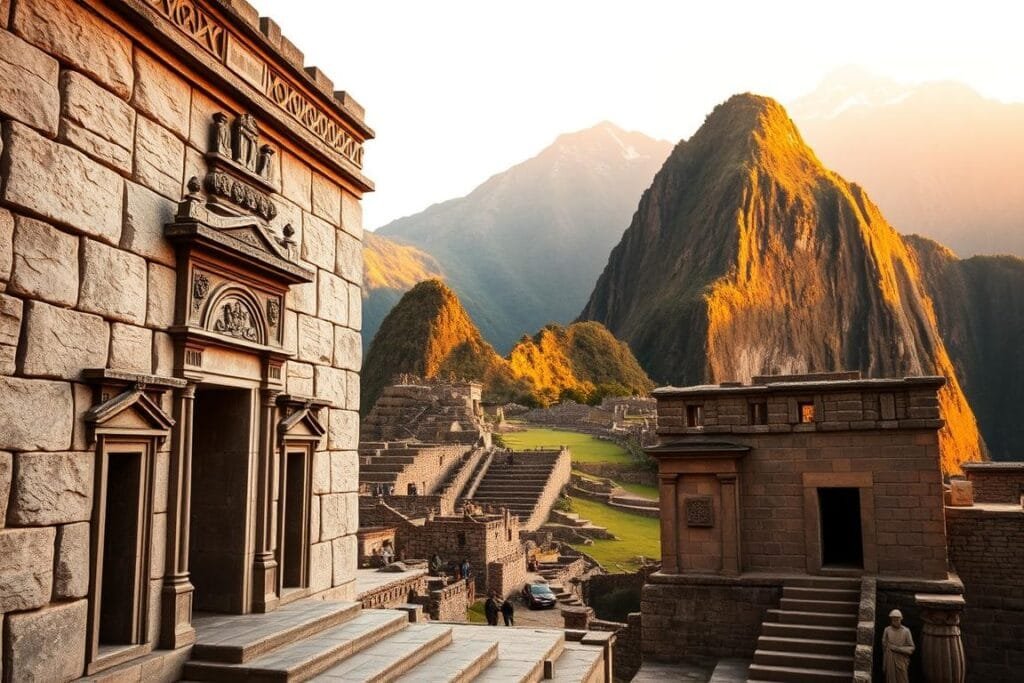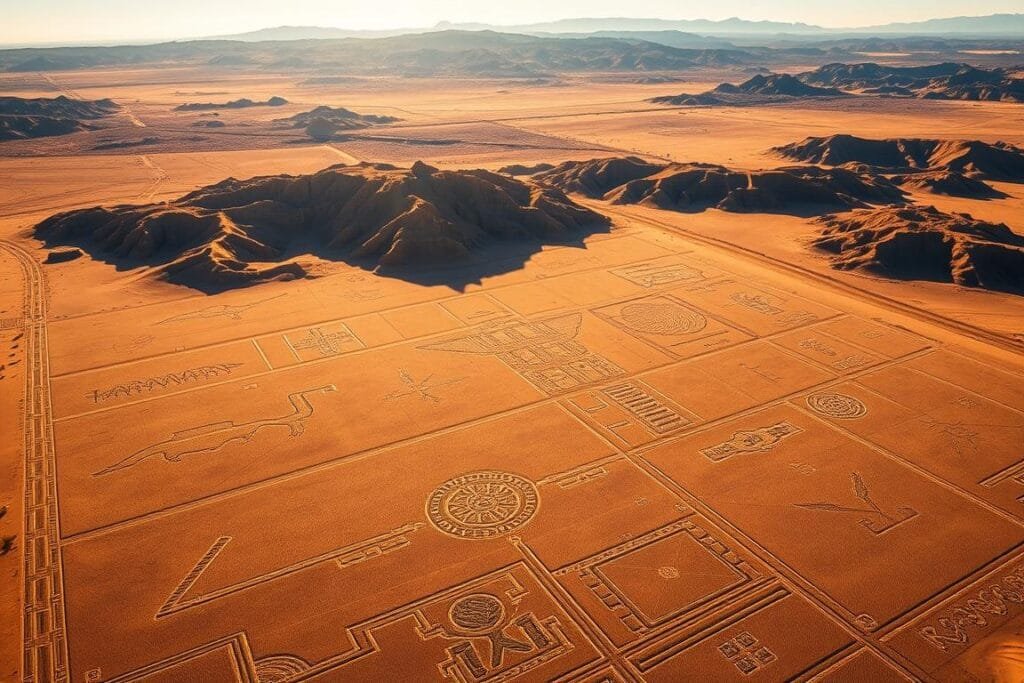Imagine standing on a windswept plateau in Peru. The whispers of ancient civilizations echo through time. Archaeologists have long been captivated by the lost empires that once dominated the Americas.
These ancient civilizations were not just scattered groups of people. They were sophisticated societies with advanced knowledge. They knew a lot about astronomy, engineering, and social organization.
From the towering stone cities of the Inca to the mysterious Nazca Lines etched across desert landscapes, lost empires of the Americas continue to challenge our understanding of human ingenuity and cultural complexity.
Our journey will uncover how these remarkable ancient civilizations developed. They built incredible architectural wonders and adapted to challenging environments. Each discovery peels back another layer of history, showing us how these lost empires were far more advanced than we ever imagined.
Key Takeaways
- Lost empires of the Americas demonstrate remarkable technological sophistication
- Archaeological discoveries continue to reshape our understanding of ancient civilizations
- These societies developed complex social and economic systems
- Geographic challenges sparked incredible human innovation
- Ancient American cultures were interconnected through extensive trade networks
Understanding Lost Empires: An Overview
Imagine stepping back in time and uncovering the secrets of forgotten kingdoms that once thrived across the. These lost empires are more than just historical notes. They are complex societies that challenge our view of human civilization.
Archaeological discoveries have changed how we see ancient cultures. Each artifact, each stone, holds a story. It’s up to researchers to uncover these mysteries of the past.
Defining Lost Empires
Lost empires are advanced civilizations that vanished or changed a lot. This happened for many reasons:
- Environmental changes
- Political upheavals
- Economic collapse
- Invasion by external forces
Characteristics of Vanished Civilizations
These remarkable societies had unique traits:
- Advanced urban planning
- Sophisticated technological innovations
- Complex social structures
- Unique cultural practices
We’re drawn to archaeological discoveries because they offer deep insights. They show us human adaptability and creativity. These forgotten kingdoms remind us that history is more complex than we think.
Every civilization leaves behind whispers of its existence, waiting for curious minds to listen and understand.
The Mighty Inca Empire: An Architectural Marvel

The Inca civilization is one of the most amazing in history. They built their homes high in the Andes. Their engineering skills are a wonder to today’s researchers.
The Incas found ways to build in the tough mountains. Their methods were truly groundbreaking. It’s amazing to think about their technology, given the secrets of their past.
Innovations in Incan Construction
Inca builders were incredibly skilled. They made several important discoveries:
- They could cut stones so well that huge blocks fit together without any glue.
- They created terraces for farming and building, which were also earthquake-proof.
The Impact of Geography on Incan Society
The Andes greatly influenced the Incas. The mountains shaped their farming, building, and way of life. They adapted to survive in this harsh environment.
“The mountains were not an obstacle, but a way of life for the Inca,” noted archaeologist Mark Guillen.
Recent Discoveries and Their Significance
Archaeologists keep finding new things about the Incas. They’ve found complex irrigation systems and ways to track the stars. These show the Incas’ deep understanding of engineering and science.
Exploring Inca history shows us a more complex and creative society than we thought.
The Mysterious Nazca Culture: Lines and Beyond

In Peru’s dry lands, the Nazca culture is a marvel of ancient times. It has left many wondering and excited. Their ruins are a treasure trove for researchers around the world.
The Nazca people lived from 100 BCE to 800 CE. They left behind a legacy that makes us rethink ancient civilizations. Their most famous work? The Nazca Lines, sprawling across the desert.
The Nazca Lines: Art or Astronomical Marker?
The Nazca Lines are a hot topic among scholars. Spanning almost 170 square miles, they feature:
- Intricate animal figures
- Geometric shapes
- Complex human designs
Experts have many theories about their purpose:
- Astronomical calendar
- Religious ritual site
- Water-related ceremonial ground
Recent Finds: Uncovering Nazca’s Daily Life
Recent digs have shown us what life was like for the Nazca. They found advanced pottery, textiles, and social structures. These discoveries highlight their cultural brilliance.
Theories Behind Nazca’s Decline
The Nazca culture’s disappearance is a big mystery. Climate change, environmental issues, and social problems might have led to their downfall. Ongoing research aims to uncover the secrets of this enigmatic civilization.
The Nazca Lines stand as a testament to human creativity and complex cultural expression.
Exploring the Mississippian Culture: Mound Builders of the South
In the heart of North America, the Mississippian culture is a lost empire that fascinates many. They changed the southeastern United States with their amazing buildings and social systems.
The Mississippian culture thrived from 800 to 1600 CE. They built complex societies with huge earthen mounds. These mounds had many uses in their communities.
Key Archaeological Sites
Cahokia is the highlight of Mississippian settlements. It’s near St. Louis and was once home to over 20,000 people. This made it bigger than many European cities back then.
- Cahokia Mounds: Primary urban center
- Moundville in Alabama: Second largest settlement
- Etowah Mounds in Georgia: Complex cultural site
Economic and Social Complexity
These ancient people had advanced economies and politics. They supported large populations. Their trade networks spanned wide areas, linking different communities.
| Economic Aspect | Key Characteristics |
|---|---|
| Trade Goods | Copper, shells, pottery, agricultural products |
| Social Hierarchy | Stratified society with clear leadership structures |
| Agricultural Practices | Maize cultivation, complex farming techniques |
The Mississippian culture is a key part of North American history. Their achievements challenge our understanding of pre-Columbian societies. They show a world of innovation, complexity, and human greatness.
The Ancestral Puebloans: Masters of the Desert
In the American Southwest, the Ancestral Puebloans show us how smart humans can be. They lived in a tough desert area and made it their home. They turned hard desert land into a place full of life.
Their amazing story is told through their incredible buildings. Their cliff homes were more than just places to live. They were engineering wonders that showed off their clever problem-solving.
Architectural Innovations in Challenging Terrain
The Ancestral Puebloans found ways to build in places that seemed impossible. They used special techniques to make:
- Multi-story stone buildings right into cliff faces
- Stone-cutting skills without metal tools
- Smart water management systems
- Settlements placed for safety
Cultural and Spiritual Dimensions
These communities were not just skilled builders. They had deep cultural and spiritual practices. Spiritual beliefs were part of everyday life. This created a way of seeing the world that respected the desert’s balance.
“The land was not a resource to be exploited, but a living entity to be respected and understood.” – Archaeological Research Insights
Today, archaeology keeps uncovering more about the Ancestral Puebloans. It shows us how adaptable and smart ancient humans were. It changes how we see prehistoric American cultures.
Uncovering the Chaco Canyon Civilization
Chaco Canyon is in the American Southwest. It’s a key site of a vanished culture in North America. This place is full of historical mysteries that draw in researchers and explorers.
The Chaco Canyon civilization was known for its engineering and social complexity. They built networks across the desert. This shows their advanced skills.
Trade Networks and Regional Influence
Chaco Canyon was a center of cultural exchange from 850-1250 CE. Their trade networks were vast. They connected many communities with roads and messages.
- Traded goods included turquoise, ceramics, and exotic materials
- Established complex communication systems across hundreds of miles
- Developed advanced road networks linking distant settlements
Astronomical Alignments and Architectural Precision
Their buildings show their architectural skill. Pueblo Bonito is the biggest and aligns with the sun and moon. It’s amazing how precise they were.
“The alignment of Chacoan structures reveals a deep understanding of celestial movements that rivals modern astronomical knowledge.” – Archaeological Research Journal
Studying these cultures teaches us about human innovation and adaptability. It shows what ancient societies could achieve.
Conclusion: The Significance of Rediscovering Lost Empires
Our exploration of Americas’ lost empires shows us more than just old stones and buildings. These ancient civilizations give us deep insights into human strength, creativity, and ability to adapt. They make us rethink how history has moved forward.
Archaeologists are finding amazing stories from these old societies. They show how these cultures solved big environmental and social problems. Their wisdom teaches us about living sustainably, designing cities, and building strong communities, lessons that are just as important today.
New technology is changing how we study these ruins. Tools like ground-penetrating radar, satellite images, and advanced dating methods are helping us discover more. These tools promise to uncover secrets that could change how we see ancient American cultures.
Looking ahead, these studies show us that humans are capable of great things. Every artifact and structure we find tells a story of human ingenuity, survival, and connection. These lost empires keep sparking our curiosity and making us question what we know about history.

